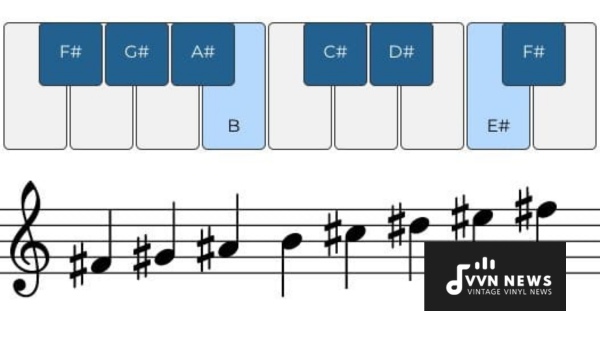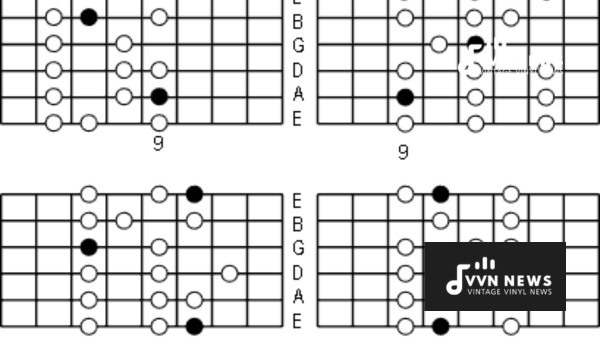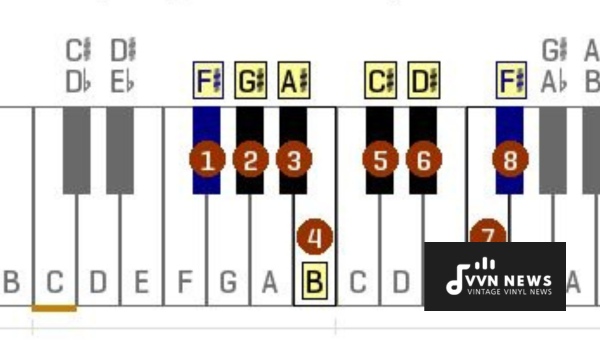If music is your refuge and piano, your canvas, you might just be on the verge of discovering a new palette – enter the F sharp major scale.
This often overlooked scale embodies everything wonderful about music: it’s vibrant yet soothing, complex yet harmonious.
With its unique combination of notes, it could be your key to creating rhythm and harmony unlike any other.
The world of music scales can often seem intimidating with its labyrinth of notes and chords.
But fear not! Understanding the F sharp major scale can be as easy as riding a bicycle: once you get a handle on it, it sticks with you for life.
Adding this gem to your musical repertoire won’t just expand your capabilities as an aspiring musician but also open up new horizons for exploration in the wide universe of sound.
How is the F Sharp Major Scale Constructed?
The F sharp major scale, like any major scale, is comprised of seven distinct notes plus an octave note.
Furthermore, it’s organized around a specific pattern of half and whole steps.
This pattern is pivotal in creating the essence of the major scale and works as follows: Whole – Whole – Half – Whole – Whole – Whole – Half; signifying the step distance between each subsequent note.
Let’s break this down:
- Starting with F sharp (F#) as our root note or tonic (1st degree), we follow a whole step to arrive at G sharp (G#) which becomes the 2nd degree.
- Our next step brings us to A sharp (A#), becoming the 3rd degree or mediant.
- We then take a half step forward to arrive at B, completing our 4th degree or subdominant.
- Following this with a whole step, we reach C sharp (C#) – 5th degree or dominant.
- From here, we take another whole step forward to achieve D sharp(D#) – our 6th degree or submediant.
- One more step leads us to E#(F natural), which serves as our leading tone or subtonic and captures the 7th-degree slot.
- We complete the scale with another half-step up arriving back once again at F#, which acts as our octave note.
As such, your complete F Sharp Major Scale, when ordered by pitch from low to high will be F#, G#, A#, B, C#, D#, E#, F#.
This unique combination of notes can provide both melody and harmony defining that characteristic sunny disposition attributed to major keys.
Also Read: A Major Triad [Master This Building Block Of Music]
Playing the F Sharp Major Scale on Piano and Guitar

When it comes to embodying the passion in music, the F Sharp Major Scale is no novice.
As we delve into playing this enchanting scale on traditional instruments like piano and guitar, you’ll discover its magic firsthand.
On the Piano
For a quick run-down: The F# Major scale incorporates seven sharps in its octave: F#, G#, A#, B, C#, D#, E#, and back to F#.
Let’s break down how to weave these notes on your piano.
- Start with your right-hand thumb (1), place on Middle C for guidance, then move it to F#.
- Press the next three keys (G#, A#) with the index (2) and middle finger (3).
- Place your thumb (1) under your palm onto B.
- Use the rest of your fingers to follow through with C#, D#, E#.
- End on F# using pinky finger (5).
For the left hand:
- Initiate by placing your little finger (5) onto F# then follow through with G# and A# using fingers 4 and 3.
- Put thumb (1) onto B. Underneath, place middle finger (3) onto C#.
- Continue accordingly through D#, E#.
- Land again on F# using thumb(1).
Practice this fingering until it feels fluid under your palms, molding a melodious musical mantra into your command.
On the Guitar
Shifting beats to guitar now – let’s weave this vivid tapestry of sound:
Starting Position: Have your index finger ready on fret two of low E string – that’s our root note: F#
- Pluck F# – fret two on low E string.
- Pluck G# and A# – fret four then six on low E string.
- Move to the next string (A) and play B, C#, D# – fret two, four, and six.
- On the D string, play E# and best on F# – fret one and three.
And voila! You’ve birthed notes that make up our beloved F sharp major scale on your guitar!
Please remember that practice is key in making these scales a second nature. Soak in the sound, and learn from it.
Become one with the rhythm. And soon, you’ll find yourself darting around the corners of this beautiful musical maze with finesse.
What Defines the Degrees of the F Sharp Major Scale?
The degrees of the F sharp Major Scale serve as a roadmap for identifying the notes and their positions.
Each degree has a designated place and function within the scale. Let’s dissect them one by one.
- 1st degree: Noteworthy is that our journey begins with F#. This is our home base or tonic, where the scale starts and ends.
- 2nd degree: G# comes in at the second spot. Some might call it a supertonic, the note just above the tonic in pitch.
- 3rd degree: Now here’s an exciting note – A#. This is known as the mediant, which is halfway between the tonic and dominant.
- 4th degree: Our fourth stop is B, also referred to as subdominant. You can think of it as below dominant in terms of pitch.
- 5th degree: Here we meet C#. This integral note holds a position as dominant–a leader in its own right because it strongly resolves back to F#.
- 6th degree: D# holds the sixth place, also identified as submediant because it’s equidistant from both tonic and octave.
- 7th degree: Last but not least we have E# or leading tone owing to its pull towards returning to F# an octave higher than where we started.
Knowing your degrees isn’t about memorizing names; rather it gives us a clear perspective on how these notes come together to form dynamic sequences within F sharp Major scale.
It’s not about order alone but also function which helps us grasp its fundamental nuances.
Also Read: Chords In C Major [The Ultimate Guitarist’s Guide]
Deciphering the Key Signature of F Sharp Major Scale

Whether you’re a budding composer or an experienced musician, the key signature is integral to expressing your creativity on paper.
For the F sharp major scale, it’s especially unique.
The Seminal Elements
The F sharp major scale is characterized by a whopping six sharps. Yes, that’s correct – F#, C#, G#, D#, A#, and E#.
These denote that every note except for B (which remains as is) has to be played one semitone higher in this scale when you scroll across a grand staff notation or set up your finger formations on various instruments.
Representation on Sheet Music
When notated, the key signature for F sharp major is placed after the clef at the beginning of a line of music.
It’s stipulated by fanning out six sharp symbols corresponding to each line or space of the grand staff that represents in order as mentioned above: F#, C#, G#, D#, A#, E#.
This cue suggests that all these are to be played sharp whenever they are encountered in the piece unless explicitly directed otherwise by accidentals.
Get into the rhythm of this musical notation and let your creativity flow uninhibited!
Notating the F Sharp Major Scale in Different Musical Clefs
Musical notation – the written or printed representation of musical tones – plays a pivotal role in communicating comprehensive musical ideas.
When it comes to transcribing the F sharp major scale onto sheet music, the distinct symbols denoting different musical clefs form the foundation for this framework.
Treble Clef Notation
The treble clef, also known as G-clef, is where you’ll notate higher notes, and is no stranger to those who play instruments like guitar or piano.
When plotting out the F sharp major scale on this staff of five lines and four spaces, we begin on the top line corresponding to F sharp (F#). The series then unfolds as follows: F#, G#, A#, B, C#, D#, E#, and back to F#.
Bass Clef Notation
On a bass clef – sometimes termed an F-clef – which is generally used for lower-pitched instruments such as bass guitar or cello, our adventure begins from the second line from the top, attributed to F#.
Moving onward then outlines this noteworthy sequence: F#, G#, A#, B, C#, D#, E# progressing again towards F#.
Alto Clef Notation
With Alto clef or C-clef utilized typically by viola players among others comes another unique layout.
For our illustrious scale, we initiate from the middle line designating to C and then transcribe the next notes on upper lines or spaces to lead us through C#(0), D#(1), E#(2), F#(-1), G#(-2), A#(3), with numerals signifying octave registers.
Mastering the guidelines for these clefs amplifies versatility in your musical vocabulary and accelerates the journey toward creating a beautiful symphony.
Just unleash your curiosity, start with simple tunes, and incrementally infuse more intricate notes from the unparalleled F sharp major scale.
What Minor Scale is Relative to F Sharp Major Scale?

To fully grasp the realm of music, it’s important to know about relative minor scales. For every major scale, there exists a parallel minor scale that shares the same key signature.
When it comes to the F sharp major scale, its relative minor is D sharp minor.
This correlation signifies that both scales have identical pitches and key signatures. However, they differ in how those pitches are presented or arranged.
Closer Look at D Sharp Minor
One colorful facet of this phenomenon lies within the structure of D sharp minor. It consists of these notes:
- D# – E# – F# – G# – A# – B – C# – D#
Notably, distinct from F sharp Major’s cheerful vibes, D sharp minor generally sounds more melancholic due to its tonal variance.
Recognizing the relationship between major and minor scales can greatly boost your versatility as an artist.
By mastering this association, you can delve deeper into changing emotions with each chord or note change when creating your melodies.
Thus, the exploration of the relative minor of F sharp major – D sharp minor – could unravel entirely new musical avenues for you to venture through.
Also Read: Chords In A Major [Deep Dive Into This Essential Scale]
Identifying the Chords Within the F Sharp Major Scale
Like every major scale, the F sharp major scale has seven different chords. We’ll explore each one below.
The Diatonic Chords in F Sharp Major
To grasp diatonic chords, let’s view them as a kind of ‘musical family’. Simply put, they are chords that naturally occur within a certain key.
Here are the primary diatonic chords in this particular scale:
To construct these chords, stack intervals of Major 3rd and minor 3rd on top of each note in the scale.
- F# Major – F#, A#, C#
- G# minor – G#, B, D#
- A# minor – A#, C#, E#
- B Major – B, D#, F#
- C# Major – C#, E#, G#
- D# minor – _D#, F#, A#
- E#/G diminished – _E#/G, A#, C#
These seven foundational chords can wield great power when mastered about each other.
Each chord maps to a specific degree in our scale and carries a distinct harmonic “flavor” due to its unique blend of notes within the total spectrum offered by the F sharp major scale (and their interrelationships).
Mastering these will open up vast new sonic possibilities and offer fresh inspiration for your musical creativity.
Also Read: B Flat Major Chords [Master This Essential Guitar Skill]
FAQs About The F sharp major scale
Why is the F sharp major scale different from other scales?
The F sharp major scale has an intriguing arrangement of notes, including six sharps, which sets it apart from other scales and gives it a distinct musical character.
What are the primary chords in F sharp major scale?
The basic chords in the F sharp major scale include F# Major, G# minor, A# minor, B Major, C# Major, D# minor, and E# diminished.
Can I use the F sharp major scale to improve my piano skills?
Absolutely! Mastering complex scales like the F sharp major can polish your skills in fingering, positioning, and transitioning between notes.
Why is music written in F sharp sound unique?
Music written in F sharp often sounds unique due to its particular configuration of sharps and intricacies that contribute to a vibrant yet harmonic resonance.
What’s an example of a song in F sharp major?
The Beatles’ classic hit “Here Comes The Sun” is a popular song written in the key of F Sharp Major.
Conclusion
In the world of music, every note, scale, and chord opens up a myriad of possibilities.
As we’ve seen, the F sharp major scale isn’t just a simple succession of pitches; it becomes part of an intricate tapestry woven with countless interesting harmonic relationships waiting to be explored.
Becoming familiar with it can open new doors in your musical journey. Remember, practice makes perfect!
The more schemas you understand, patterns you identify, and sounds you cultivate, the better musician you become.








